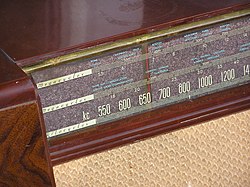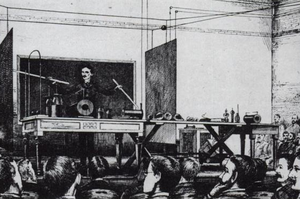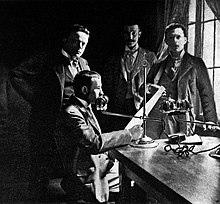Radio is the transmission of signals through free space by modulation of electromagnetic waves with frequencies below those of visible light. Electromagnetic radiation travels by means of oscillating electromagnetic fields that pass through the air and the vacuum of space. Information is carried by systematically changing (modulating) some property of the radiated waves, such as amplitude, frequency, phase, or pulse width. When radio waves pass an electrical conductor, the oscillating fields induce an alternating current in the conductor. This can be detected and transformed into sound or other signals that carry information.
 Classic Radio
Classic Radio




 Classic Radio
Classic Radio 
Tesla demonstrating wireless transmissions during his high frequency and potential lecture of 1891. After continued research, Tesla presented the fundamentals of radio in 1893.
In 1896, Marconi was awarded British patent 12039, Improvements in transmitting electrical impulses

and signals and in apparatus there-for, for radio. In 1897, he established a radio station on the Isle of Wight, England. Marconi opened his "wireless" factory in Hall Street, Chelmsford, England in 1898, employing around 50 people. Shortly after the 1900s, Marconi held the patent rights for radio.
20th century

The next advancement was the vacuum tube detector, invented by Westinghouse engineers. On Christmas Eve, 1906, Reginald Fessenden used a synchronous rotary-spark transmitter for the first

radio program broadcast, from Ocean Bluff-Brant Rock, Massachusetts. Ships at sea heard a broadcast that included Fessenden playing O Holy Night on the violin and reading a passage from the Bible. This was, for all intents and purposes, the first transmission of what is now known as amplitude modulation or AM radio. The first radio news program was broadcast August 31, 1920 by station 8MK in Detroit, Michigan, which survives today as all-news format station WWJ under ownership of the CBS network.
UK:
in contrast, related developments in the United Kingdom saw the British High Court uphold Marconi's British Patent 7,777 that was issued on April 26, 1900. This British patent held by Marconi disclosed a four-circuit system, which was strikingly similar to a four-circuit system disclosed in U.S. patent #645,576 that was issued earlier to Tesla on March 20, 1900. On the matter of invention, it is held that Marconi knowingly and unknowingly used the scientific and experimental work of many others who were devising their own radio tuning apparatus' around the same time, such as the work of American electrical engineer John Stone Stone who was issued several U.S. patents between 1904 and 1908. However, what made Marconi more successful than any other was his ability to commercialize radio and its associated equipment into a global business.]









